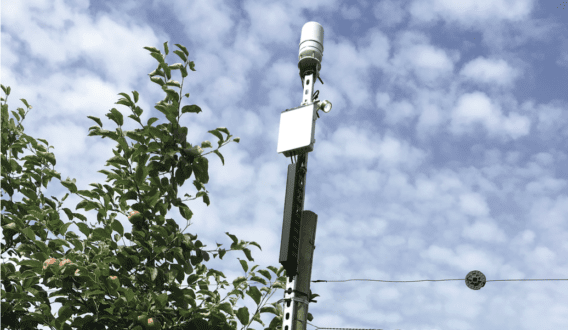

Jan 24, 2020New technology more precise in weather monitoring
There’s a growing trend in Washington state for growers to purchase their own, on-site weather stations. And soon, AgWeatherNet, a network of weather stations around the state, plans to have technology available to help farmers better utilize these systems.
“Forecasting is challenging in Washington,” with its variety of topography, including rolling hills and small basins, observed Joe Zagrodnik, a post-doctoral research associate with AgWeatherNet. A weather service monitoring station a couple of miles away from a farm may not address the nuances, or “micro-climate,” of that specific area, he said.
Yet, once a grower installs his or her own weather station, there can be confusion about its operation – and more maintenance than expected, Zagrodnik told Fruit Growers News, following an address to the Washington State Tree Fruit Association’s Annual Meeting & Northwest Horticultural Expo in December in Wenatchee, Washington.
Late last year, AgWeatherNet began offering growers the opportunity to incorporate qualifying private weather stations into its overall network. This offers the grower access to a “weather dashboard,” data management and decision support models, said Dave Brown, director of AgWeatherNet and associate professor of soil science at Washington State University (WSU). In addition, a free phone app is in the testing and development stage, which will help with everything from detecting problems with the station, to tracking information from previous months and alerting the grower to necessary actions in the field.
With funding from WSU, the Washington State Tree Fruit Commission and the Oregon Sweet Cherry Commission, the app – expected to be available later this year – will deliver “hyper-local weather forecasting.” For example, it will deliver information on the number of “degree days” thus far in a year, and a “cold-hardiness model” to determine when buds are the most vulnerable. It may even sense when a rain gauge on a weather station is plugged, comparing data from other nearby monitoring stations.


“We’ve had a lot of interest from growers installing weather stations on their own,” Zagrodnik said.
This new technology developed by AgWeatherNet also will give a more specific forecast for a grower’s exact site.
“Each orchard has its own microclimate and weather,” Zagrodnik said. Even if a grower has three adjacent orchards, there may be differences in elevation and moisture levels, with slightly different needs for everything from spraying to use of wind machines. By getting more precise information, it may be possible to avoid some unnecessary costs, he said.
AgWeatherNet already has about 175 of its own weather monitoring stations placed around Washington state, with a concentration in farming regions such as the Yakima Valley, Zagrodnik said. Yet, these stations follow more traditional protocols for placement in open, grassy areas. With connections to stations in orchards, vineyards and fields, more detailed information can be received and processed.
AgWeatherNet also can offer growers advice on the maintenance that will be required for various weather stations they may purchase from a handful of dealers. These devices may run “in the low $2,000s,” and typically are in the form of either a box or several pieces which include a rain gauge, wind sensor and air temperature sensor. They are to be mounted on a pole, perhaps just above the tree canopy, or about one and a half meters above the ground for vines or field crops, to give the most representative data.
Zagrodnik credits the National Weather Service for all that they do, but notes that “they have a lot on their plate.” They cover vast geographical areas and tend to offer weather information based upon a more generalized grid that is not necessarily “ag-specific” nor based on a precise orchard or vineyard location. Other private services may offer more site-specific weather details, but at a price.
When the free AgWeatherNet app is made available later this year, it will allow data from the grower, and back to the grower, to be accessed from a cell phone or laptop. For more information, visit www.weather.wsu.edu.














